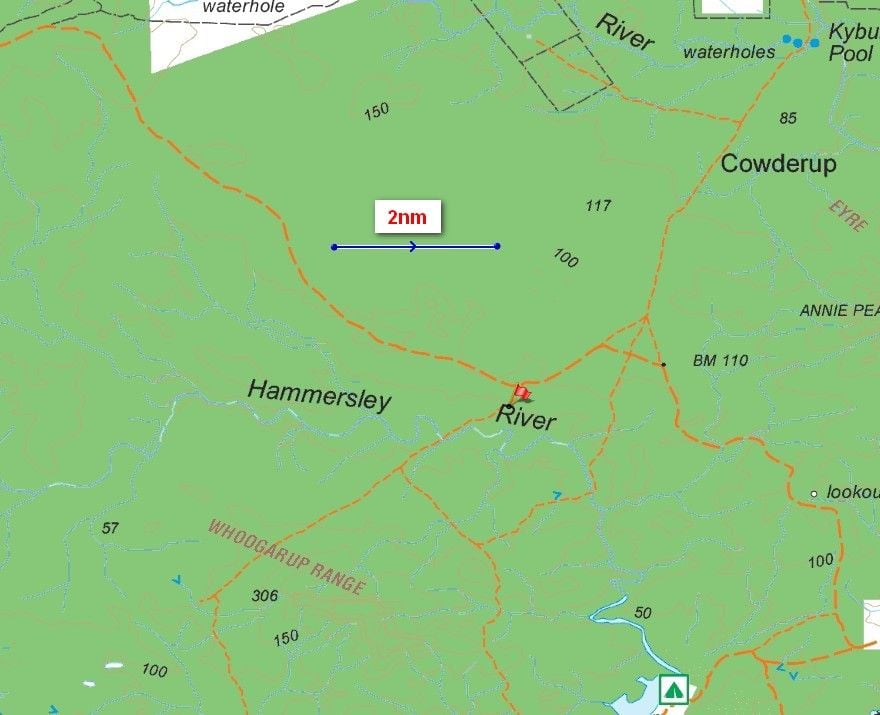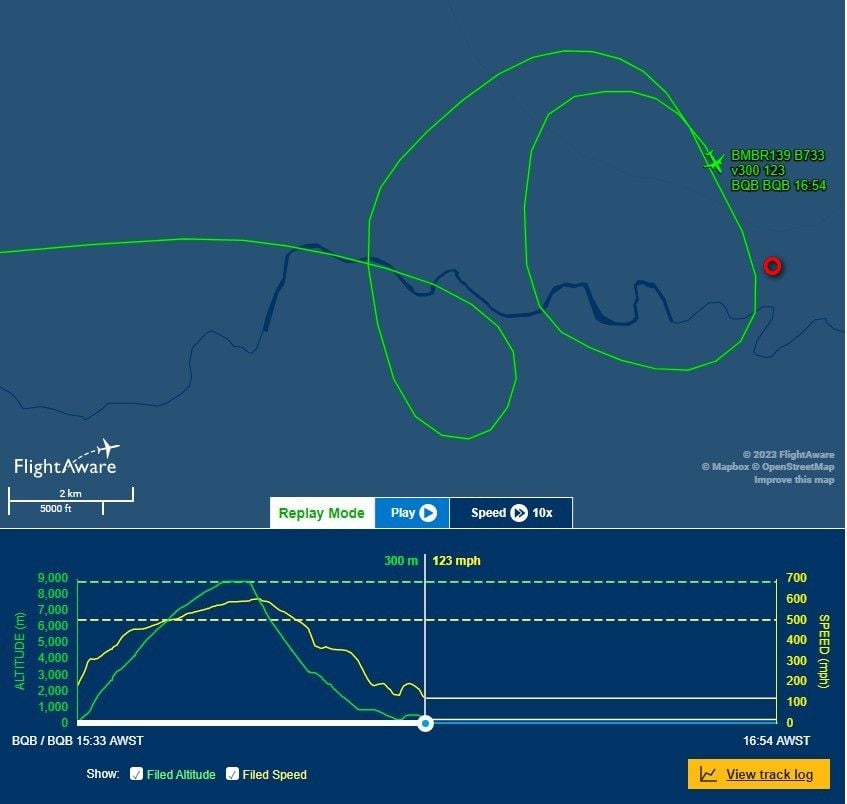Fire Fighting 737 Crashed in WA
Originally Posted by 43Inches
In the video below you can see the pilots scan approaching the target and the workload he is under, and then during the drop and recover there is a lot of flying happening... Imagine that with speed multiplied in a large jet.
Similarly, in WA, in an area where there doesn't appear to be any relevant terrain, they are doing tight descending turns at low speed just before the drop, and according to the FlightAware track, didn't do a dummy run first, just a fairly tight orbit to the west of the target area.


Originally Posted by TDRacer
IF it was pilot error and they either struck the ground or stalled trying to avoid ground contact, the critical visibility would have been what's below, not what's above. How would eyebrow windows help?
Last edited by Capn Bloggs; 11th Feb 2023 at 02:26. Reason: Flightaware image updated
The following users liked this post:
In the LATs the workload is halved with the introduction of the second pilot. RJ85 crew (Dubbo) have suggested that the FO manages engines and airspeed indications only and does not monitor terrain. The pilot flying manages the airframe and drop sequence and should be the one monitoring terrain at all stages of the drop sequence including the departure from the orbit. It is the decision making during the approach to the drop that seems to be the issue during the emerging pattern of LAT incidents/accidents. Yes they are managing a higher work load at low level, but, that's what they are there for and what they have been trained for. If there is a shortfall, it needs to be addressed. These flight crews are evidently experienced, intelligent people. Are they being strangled by poorly resolved procedures?
Originally Posted by Lucerne
the absence of a turn window isn't attributable to CFIT.
Maybe the hill in that image, possibly unexpected in that relatively featureless terrain, was unnoticed by the crew until late in the drop run, whereupon back-stick was applied abruptly leading to stall and ground contact. Just speculation.
Hats off to those guys doing a dangerous job for less $$$ than the ones who flew the same jet when it was a SWA machine.
Hats off to those guys doing a dangerous job for less $$$ than the ones who flew the same jet when it was a SWA machine.
I wouldn't mind betting that the cause was a stall from a too low and too slow scenario in an inappropriate configuration. That seems much more likely than a power loss on that aircraft and was the overall (nutshell) cause with regard to T134. We'll soon see I suppose. (well, maybe much later than soon as these things evidently take time). When the footage becomes more public this will become more evident I'm sure.
I have trouble with the stall theory. I agree they would have been at the back of the power curve, possibly with the stick shaker rattling away but not fully stalled. That aeroplane touched down gently enough not to break its back and slid more or less intact to a full stop. Fully stalled they would have hit much harder. AF447 in the South Atlantic quickly developed a sink rate in a fully developed stall of over 11,000 feet/min.
An empty 737-300 Freighter has a basic weight of around 31 tons. I have no idea on the weight of the fixed firefighting gear but assuming they had at least the fuel to go home plus reserves I would take a guess they would be around the 40-ton mark. A close friend who has flown this kind of operation claims 120 knots is an ideal dropping speed. This would place them at these weights very close to VREF with little margin for error. Smoke coupled with a subtle rising ground, and it is not hard to see a ground contact threat.
737's have a habit of breaking the fuselage both forward and aft of the wing box section. The 737-200 in the Hawaiian ditching was a classic example. A professional crew like this one would not have allowed a fully developed stall to occur. They may have run out of performance options and even allowed it to touch down to avoid a stall.
Anyhow, whatever the cause a lucky crew and a great outcome.
An empty 737-300 Freighter has a basic weight of around 31 tons. I have no idea on the weight of the fixed firefighting gear but assuming they had at least the fuel to go home plus reserves I would take a guess they would be around the 40-ton mark. A close friend who has flown this kind of operation claims 120 knots is an ideal dropping speed. This would place them at these weights very close to VREF with little margin for error. Smoke coupled with a subtle rising ground, and it is not hard to see a ground contact threat.
737's have a habit of breaking the fuselage both forward and aft of the wing box section. The 737-200 in the Hawaiian ditching was a classic example. A professional crew like this one would not have allowed a fully developed stall to occur. They may have run out of performance options and even allowed it to touch down to avoid a stall.
Anyhow, whatever the cause a lucky crew and a great outcome.
Last edited by By George; 18th Feb 2023 at 20:52.
The following users liked this post:
In post #196, 43Inches shared link to the 7 News footage of the crash site and in #200 Eclan shared a screen shot from that video. In both, you can see multiple mitred (or turn-out) drains on the side of the dirt track where the 737 came to a rest. These are forking off from the opposite side of the track than from where the 737 had approached. These drains are used to direct rainwater to the land below the road which indicates that the 737 skidded downhill at least at the end of its run across the ground. That is consistent with the ATSB comment about the 737 clipping a ridge.
In post #98, Checkboard indicated the stall speed of a lightly loaded 737 with full flaps is around 90 knots, with an approach speed of 130 knots. Others have indicated final data from the 737 on FR24 indicated a ground speed of only about 100 knots (presumably while still flying).
While it is a different airliner, I was reminded of the accident involving the Air France A320 back in 1988 doing a low altitude and low speed airshow pass when it collided with trees and crashed. The Wikipedia write-up of this accident is at: https://en.wikipedia.org/wiki/Air_France_Flight_296Q . An extract from this has: "flyover... was supposed to take place at an altitude of 100 feet (30 m); instead... the flyover at 30 ft (9 m), skimmed the treetops of the forest at the end of the runway (which had not been shown on the airport map given to the pilots) and crashed.. All... survived the initial impact, but a woman and two children died from smoke inhalation before they could escape...". The rest is also worth reading. Wiki indicates its airspeed fell to as low as 122 knots before it hit trees. Look at the video to see just how slowly it was passing:
I haven't seen it reported here previously, but at https://www.atsb.gov.au/statements the ATSB has a statement from 11 Feb indicating: "...On Friday they [ATSB] welcomed a team of six investigators from the National Transportation Safety Board..., the Federal Aviation Administration ... and Boeing". That isn't really surprising, but good to read.
Meanwhile, I see from FR24 that Coulson and others are continuing to firebomb the fire in the same general area. Their C130H, N132CG was operating to the fire earlier today. It is a considerable round-trip from Busselton.
In post #98, Checkboard indicated the stall speed of a lightly loaded 737 with full flaps is around 90 knots, with an approach speed of 130 knots. Others have indicated final data from the 737 on FR24 indicated a ground speed of only about 100 knots (presumably while still flying).
While it is a different airliner, I was reminded of the accident involving the Air France A320 back in 1988 doing a low altitude and low speed airshow pass when it collided with trees and crashed. The Wikipedia write-up of this accident is at: https://en.wikipedia.org/wiki/Air_France_Flight_296Q . An extract from this has: "flyover... was supposed to take place at an altitude of 100 feet (30 m); instead... the flyover at 30 ft (9 m), skimmed the treetops of the forest at the end of the runway (which had not been shown on the airport map given to the pilots) and crashed.. All... survived the initial impact, but a woman and two children died from smoke inhalation before they could escape...". The rest is also worth reading. Wiki indicates its airspeed fell to as low as 122 knots before it hit trees. Look at the video to see just how slowly it was passing:
I haven't seen it reported here previously, but at https://www.atsb.gov.au/statements the ATSB has a statement from 11 Feb indicating: "...On Friday they [ATSB] welcomed a team of six investigators from the National Transportation Safety Board..., the Federal Aviation Administration ... and Boeing". That isn't really surprising, but good to read.
Meanwhile, I see from FR24 that Coulson and others are continuing to firebomb the fire in the same general area. Their C130H, N132CG was operating to the fire earlier today. It is a considerable round-trip from Busselton.
I see it as a replay of this near miss. The pilot stated,
The 737 guys were in the same place as the RJ85, rising terrain in front of them, in the RJ case those experienced commented that the hill they missed tended to blended into the background of the still higher terrain.

While conducting retardant operations I descended below a ridge crossing altitude. This was NOT on purpose. I tunnel visioned the drop, and continued down. This was a little fill in spot and I was really focused on finishing the line. As I stated, this was NOT on purpose. We{crew} debriefed and talked about what happened, and of course, how to prevent this type of screw up.

The following users liked this post:
The following 4 users liked this post by dejapoo:
We must remember these pilots are not flying from ILS to ILS sipping on a cuppa tea in an airline. It is a very demanding job with low flying, heat and mechanical turbulence, wind shear, reduced vis in smoke and undulating terrain.
They survived in one piece. The jet is replaceable.
A good outcome in the circumstances.
They survived in one piece. The jet is replaceable.
A good outcome in the circumstances.
The following 4 users liked this post by The Banjo:
Originally Posted by Banjo
A good outcome in the circumstances.
Humans
The world has changed Cpt Bloggs. I agree entirely with your sentiment about the flying outcome here, but fire fighting is now also about protecting any valuable or irreplaceable assets such as certain pieces of forest or bushland. The aircraft should have been there, but flown in an entirely different manner.



